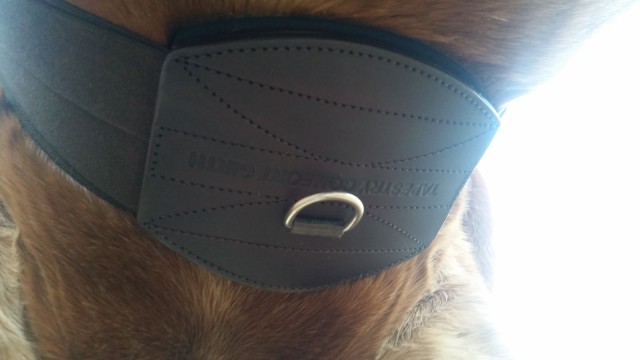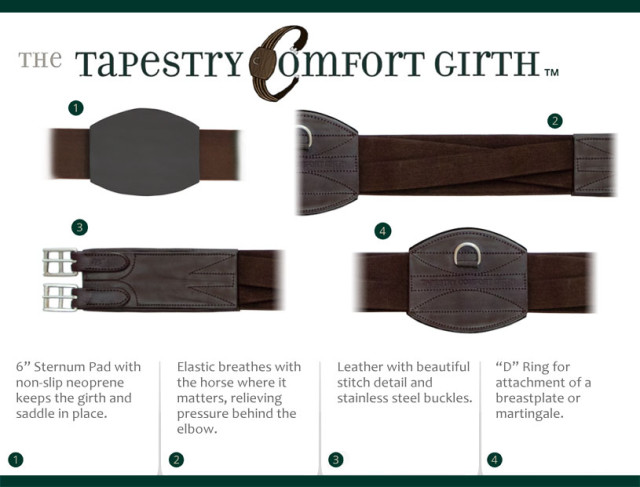Who doesn’t love shopping, especially when the object of your search is new gear for yourself or your horse? As an enthusiast of all products equine, I LOVE trying out new gear. Please join me as I narrate my personal journey of trying out all of the products featured. While I will make no recommendations, I hope you have fun reading about my many adventures of trying new products, and that hearing about my personal experiences helps you on your own quest for new gear. Go Shopping.
 Looking back to the center of the girth…the 6″ sternum pad is made of the same quality leather, and it features a D ring for a breastplate or martingale. And on the side of the pad that comes into contact with your horse, a non slip neoprene will help to keep the pad in place. Photo by Lorraine Peachey.
Looking back to the center of the girth…the 6″ sternum pad is made of the same quality leather, and it features a D ring for a breastplate or martingale. And on the side of the pad that comes into contact with your horse, a non slip neoprene will help to keep the pad in place. Photo by Lorraine Peachey.
Looking back to the center of the girth…the 6″ sternum pad is made of the same quality leather, and it features a D ring for a breastplate or martingale. And on the side of the pad that comes into contact with your horse, a non slip neoprene will help to keep the pad in place. Photo by Lorraine Peachey.
I’m not especially fond of jeans that fit a little too snugly. They tend to pinch at the waist and are really not comfortable in the very least. Which helps when I try to relate to the fact that my quarter horse gelding Ripley has been girthy during the whole time I’ve owned him.
When it’s time to tack Ripley up for a ride, I’ve developed a routine. Place saddle pad on back. Add saddle. And of course, tighten girth. Something that really behooves me though, is to not forget that Ripley becomes irritated that this point, and reaches around to bite.
It’s true that I’ve become quite adept at dodging Ripley as he tries to bite me, while I tighten his girth. Even though I tried to address the issue in the past, I’ve never made any headway. It’s a habit that I’ve found easier to side step and then ignore.
Over the years, I’ve even tried different girths with Ripley. I’ve been happy to find him to be happier and more accepting of some, which has definitely been a good thing for him. But I was pretty interested when I first saw a video about an entirely different looking girth.
When I first saw a video of the Tapestry Comfort Girth, I was intrigued at the concept. A girth that is designed for the comfort of the horse, so that it can breathe and expand evenly when needed? This, I absolutely had to see in action.
So let’s break it down and look at what makes the Tapestry Comfort Girth different than a traditional girth. The most striking difference is the elastic. While most girths have elastic ends, the Tapestry Girth is pretty much the opposite of what most are used to.
The Tapestry Girth is crafted with leather at both ends, along with a sternum pad in the center. The rest of the girth? That’s made out of three bands of elastic that are woven together, so that it can BREATHE with your horse, and eliminate pressure behind the elbow. Close up view of the 6″ sternum pad, with a non slip neoprene backing. Photo by Colleen Peachey.
Close up view of the 6″ sternum pad, with a non slip neoprene backing. Photo by Colleen Peachey.
The leather at either end of the Tapestry Girth feels to be of durable and of high quality. And, the leather boasts lovely stitching detail as well. The ends also feature two stainless steel buckles on each of them.
Looking back to the center of the girth…the 6″ sternum pad is made of the same quality leather, and it features a D ring for a breastplate or martingale. And on the side of the pad that comes into contact with your horse, a non slip neoprene will help to keep the pad in place.
I was pretty excited to try out the Tapestry Comfort Girth on my own horses. Really, I wanted to observe whether they appeared to feel a difference when wearing it, versus a traditional type of girth. The concept of the elastic really had me intrigued.
I’ve worn the Tapestry Girth on two of my horses, first on my ‘girthy’ gelding, Ripley. When I tacked Ripley up with the Tapestry Girth for the first time, I approached tightening it the same as I would a traditional girth. Nice and slowly…while keeping an eye out for him to try biting me.
Except for the fact that he didn’t. I was careful to tighten the girth slowly, as I would any other girth. And he completely shocked me when he did not reach around to try to bite me. After this lack of reaction, I was even more interested to see how he acted under saddle.
While riding with the Tapestry Comfort Girth, Ripley gave all indications that he was happy and comfortable with his work. I would even say that he is seems to be overall less moody and more cooperative when I’m asking him to work.
It’s safe to say that I was exceedingly happy with how the Tapestry Girth has worked out for Ripley. And I also wanted to try it out on my young DWB/TB gelding, Rufus, who started under saddle last year. Roo is a sensitive horse, who took some getting used to the feel of the girth early on.

In the early stages of getting him started, Roo spent a good bit of time lunging under tack. And while getting used to it, he definitely threw in some “silly pony antics” (as I like to call them), because he kept getting pinched by the girth I was using.
I was interested to try the Tapestry Girth out on Roo, since he is a sensitive green bean of a horse. Roo started wearing a Tapestry Girth after his training was well underway, and his “pony antics” had already noticeably decreased.
Which is a little sad, because I think he must have started to get used to the pinching feeling of the traditional girth. Observing Roo after he started wearing the Tapestry girth, I found that he appeared to be comfortable moving forward.
And when I was in the saddle, I found that Roo was well behaved for me. Again, he seemed comfortable moving under tack, and I did not experience any “silly pony antics”…which is a blessing, since I’m not a super adventurous rider!
I was happy that the Tapestry Comfort Girth worked well for me on two completely different horses. They are different types of horses, are of different age groups, and at two very different places in their training. How many ways can I use the word different?
The Tapestry Girth appeared to provide a benefit for both Ripley and Roo, for which I was very happy. Cleaning the girth is important, as I’m often someone who slacks off when it comes to tack cleaning. The leather should be cleaned with saddle soap and oil, and the elastic with a wet dandy brush and non chemical shampoo.
The Tapestry Comfort Girth is brought to you by the creator of the Spursuader (you can check out our review of them here). The English Girth is available in brown easy care leather in sizes 38″ to 54″, and retails for $149. You can find them here. And you can also check out a video about the Tapestry Comfort Girth here.
Go Comfort for Your Horse. Go Tapestry Comfort Girth. Go Jumping.
